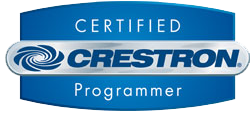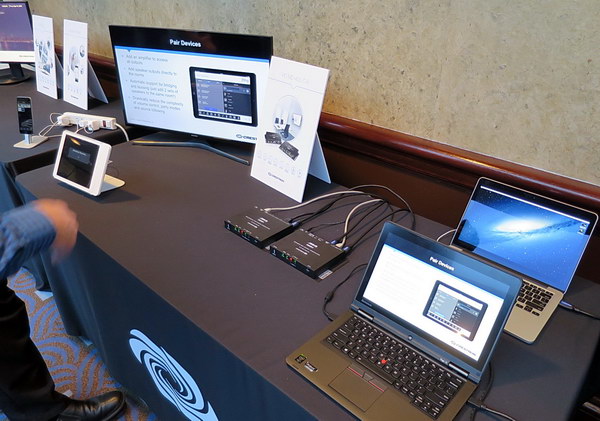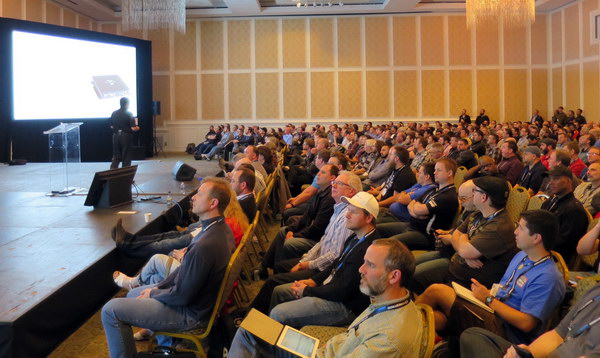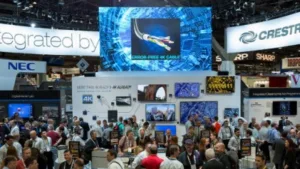For years, people have been talking about the migration of professional and home audio video, from classic A/V with dedicated video cables, matrix video switchers and RS-232 control to a more IT-centric approach. Some companies that have not managed to make this AV to IT transition have vanished.

Crestron is one company that seems to have managed the AV to IT transition for video, audio and related applications quite nicely. The company says it provides custom solutions for any need. More specifically, they say “we build the technology that integrates technology. Our automation and control solutions for buildings and homes let people control entire environments with the push of a button, integrating systems such as A/V, lighting, shading, IT, security, BMS [building management system], and HVAC to provide greater comfort, convenience, and security. All of our products are designed and built to work together as a complete system, enabling you to monitor, manage, and control everything from one platform.”
 Simple Crestron 4K Demo in 2014
Simple Crestron 4K Demo in 2014
I’ve been to the Crestron booth at various large and small trade shows and had demonstrations of Crestron touch screen panels where, at a simple touch, a Crestron switcher will re-direct video from a variety of third-party video sources to a variety of third-party displays. These sources and displays are of differing resolutions and frame rates and the system takes care of the issue of delivering the right kind of video to the right display. They were showing complete 4K systems at a demo like this that I saw in 2014, where some of the displays could handle 4K inputs but others could not. For the displays that would not accept 4K input, the video was downscaled by the system before delivery.
At the time, the 4K hardware was what I was writing about. I didn’t really think about how the touch screen panel talked over Ethernet to the switcher, the scaler or the display. That was software, i.e. that was someone else’s problem, not mine. But software is a big problem that gets much bigger as the system grows.
When building a corporate AV structure for a global company, the hardware will be deployed in various combinations in large numbers of world-wide huddle rooms, conference rooms, board rooms, auditoriums, etc. Each room worldwide has its own hardware and displays that needs to be accommodated. The software needed to allow a huddle room to connect to either a huddle room down the hall or a corporate boardroom half a world away becomes increasingly, even astonishingly, complex. And then you throw in the board room lights, curtains and moving screens. And what if the video and data from the huddle room needs to travel over the public Internet to the destination half a world away? Just apply 256-bit encryption to protect it. Since it’s a 2-way video conference, make sure there is minimal latency time in the link. Next, you need to think about scheduling all these rooms worldwide. Of course, each corporate location has a security staff that can monitor a variety of technologies from door locks to security cameras.
Even if you are dealing with a much simpler situation, for example the Crestron booth at InfoComm 2015, the variety of sources, touch screen controllers, switchers, scalers, encoders, decoders and displays can be bewildering, especially if a company like Crestron wants to include at least one example of every hardware product they sell. This may be “simpler” than a corporate global installation, but it’s still not simple. Plus, it must work. Crestron can’t tell visitors to its booth “It doesn’t work here at InfoComm but buy our products and we’ll be able to make it work for you in your board room.” A statement like that would be a non-starter, from a potential customer’s point of view.
 Crestron booth at InfoComm 2015
Crestron booth at InfoComm 2015
The interaction of devices in a trade show booth or a global corporation is a massive software problem and Crestron approaches it with training, training, and more training for the Crestron employees and the third party system developers and installers that have to make these massive networks work seamlessly and transparently to end users.

The first step in this training is provided by the Crestron Technical Institute, which provides the individuals who will be programming Crestron systems with the software training they need to make systems work in real life. This training starts with two on-line training sessions, Crestron 101 and Toolbox. From there, programmers move to a series of in-person training sessions starting with CTI-P101 Foundations of Crestron Programming through CTI-P301 Advanced Programming Skills. Then, after a take-home exam, you become a Crestron Certified Programmer. Currently there are a total of 1256 certified programmers world wide, including 763 in the US and 204 in EMEA.
Then the real fun begins. A series of two on-line and five in-person sessions may make you a Crestron Certified Programmer but you still don’t know everything there is to know about programming Crestron systems. This is addressed by the Crestron Masters conference, which has been held every year since 2002. This year’s conference was held April 12 – 14 at the Doral Arrowwood conference center in Purchase, New York. Attendance at the Crestron Masters is by invitation only, and invitations are sent to all Crestron Certified Programmers. According Dina Khiry, Social Media Manager at Crestron, about 600 were expected to attend and Crestron was surprised (pleasantly, I presume) when 650 signed. This included about 570 US and 80 international attendees. For EMEA Crestron programmers and others that couldn’t make it to New York, there is a second Crestron Masters program session in Amsterdam, May 17-19th. Khiry added that there are no registration fees for Crestron training, including both the CTI and Crestron Masters, although attendees pay their own travel and lodging.
 The modest display of hardware outside the main conference room focused on how the software could connect the devices together.
The modest display of hardware outside the main conference room focused on how the software could connect the devices together.
This high turnout required certain accommodation on Crestron’s part. For example, it was necessary to set up an auxiliary viewing area in the lobby outside the largest room used in the Masters, which could only accommodate about 600. I think it’s safe to say the video and audio were routed to this area using Crestron hardware and software.
There were 27 different classes offered in a total of 70 training sessions. This repetition was needed because there were up to eight parallel class sessions. Classes ranged from the relatively introductory “SIMPL# Primer” (remember, all attendees are already Crestron Certified Programmers) through very specific topics such as “Streaming with Touchscreens” to advanced topics such as “DM Troubleshooting – DMPS & 4K.” Most sessions were scheduled for 1-1/2 hour time slots, although a few were programmed into two successive sessions.
 Standing room only crowd at the concluding session, “Looking Ahead to 2016.” New Crestron products to be available in the next 30 – 90 days were discussed. In addition, the new Diamond awardees were honored at this session.
Standing room only crowd at the concluding session, “Looking Ahead to 2016.” New Crestron products to be available in the next 30 – 90 days were discussed. In addition, the new Diamond awardees were honored at this session.
Attendance at Crestron Masters and passing advanced exams leads to certification beyond Crestron Certified Programmer. Four levels are currently offered: Silver, Gold, Platinum and Diamond. Each level requires taking advanced classes at three years worth of the Crestron Masters, so you know a Diamond level programmer has at least 12 years experience programming Crestron systems. Currently, Crestron has 232 Silver, 45 Gold, 8 Platinum and 4 Diamond level programmers. Reaching Diamond level requires more than just taking classes and passing exams: you must demonstrate your ability to teach Crestron programming to others as well. Of the four Diamond level programmers, two, Jon Ottesen and Steve Swartzentruber, work for Crestron. The third is Tom McLaughlin, Director of Technical Operations at Dobil Laboratories Inc. and the fourth is Jim Pope, Technical Director at Applied Global Technologies. Tom, Jon and Steve were awarded their Diamond certifications at the concluding meeting of the Crestron Masters 2016. Congratulations to them! If I ever have any questions about Crestron software, I’ll know who to ask.
– Matthew Brennesholtz

